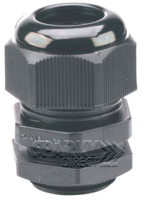Search Results:
Search Results:
Search Results:
Search Results:

Cable glands play a vital role in ensuring secure and reliable cable connections in various industries. Whether you're dealing with power cables, communication cables, or data cables, cable glands provide a protective seal and strain relief, preventing moisture, dust, and other contaminants from entering the cable termination points. Let's explore the significance of cable glands, their types, materials, and installation methods, highlighting their importance in maintaining optimal performance and safety.
Cable glands are an essential component of cable management systems, designed to provide a secure entry point for cables into electrical enclosures, control panels, junction boxes, or equipment housings. Also, PVC cable glands are required when cables need to penetrate a weatherproof box to allow cables to pass in or out of the weatherproof box. These robust devices offer numerous benefits, including:
Protection: Cable glands offer protection against environmental factors such as moisture, dust, and corrosive substances, safeguarding the cables and the equipment they connect to.
Strain Relief: By providing strain relief, cable glands reduce the risk of cable damage from excessive tension or pulling, ensuring longevity and reliability.
Safety: Cable glands help maintain a safe working environment by minimizing the potential for electric shocks, short circuits, and fire hazards.
Cable glands come in a wide range of types and designs, each suited for different applications and cable types. Here are some commonly used cable glands:
Nylon Gland: Nylon cable glands are lightweight, cost-effective, and suitable for both indoor and outdoor applications. They provide excellent resistance to corrosion, chemicals, and UV radiation. Nylon cable glands are widely used in various industries, including telecommunications, automation, and electronics.
Metal Gland: These cable glands are typically made of brass, stainless steel, or aluminium and offer excellent mechanical strength and resistance to environmental conditions. Metal cable glands are commonly used in industrial settings, where durability and protection against harsh environments are crucial.
Thread Types: Cable glands feature different thread types, such as metric, NPT (National Pipe Thread), or PG (PanzerGewinde). Choosing the appropriate thread type ensures a proper and secure fit between the gland and the equipment or enclosure.
When choosing a cable gland, it is important to consider the specific requirements of your application. Here are some factors to consider:
Cable Size and Type: Determine the cable diameter and type (e.g., armoured, unarmored, fibre optic) to select a cable gland that provides an optimal fit and sealing performance.
Environmental Conditions: Assess the environmental factors, such as temperature, moisture, and exposure to chemicals, to choose a cable gland that offers suitable protection against these conditions.
Certifications and Standards: Ensure that the cable gland complies with relevant industry standards and certifications to guarantee its quality and reliability.
Proper installation of cable glands is crucial for maintaining a secure and reliable cable connection. Follow these steps for a successful installation:
Preparation: Ensure that the cable and the equipment or enclosure are clean and free from debris. Remove any sharp edges or burrs that may damage the cable sheath.
Selecting the Right Size Gland: To determine the size of a cable gland, you need to consider the outer diameter of the cable you are using. Cable glands are available in various sizes to accommodate different cable diameters. The size of the cable gland should match or be slightly larger than the outer diameter of the cable to ensure a proper fit and effective sealing.
Making Cable Entry: Carefully strip the cable insulation, leaving the required length exposed. Insert the cable through the cable gland, ensuring that it passes through the sealing element.
Tightening and Securing: Use the appropriate tools to tighten the cable gland's locknut or compression mechanism. Ensure that the gland is securely fastened but avoid over-tightening, as it may damage the cable or the gland.
Testing: Conduct a visual inspection to ensure the gland is properly installed and the cable is securely fixed. Perform any necessary tests to verify the integrity of the cable connection.
Cable glands are indispensable components when it comes to a secure cable connection. By providing protection, strain relief, and maintaining safety standards, cable glands play a crucial role in various industries and applications. When selecting a cable gland, consider factors such as cable size, environmental conditions, and industry standards. Proper installation ensures a secure connection, reducing the risk of cable damage and ensuring optimal performance. Invest in high-quality cable glands and follow the recommended installation procedures to enjoy reliable and long-lasting cable connections.
If you're after 12mm Cable Gland Black, 16mm Cable Gland Black, 20mm Cable Gland Black, 25mm Cable Gland Black, 32mm Cable Gland Black, 40mm Cable Gland Black, 50mm Cable Gland Black, 63mm Cable Gland Black look no further. Sparky Direct is your online electrical wholesaler to supply all your cable gland needs!
Find your perfect cable gland at Sparky Direct!